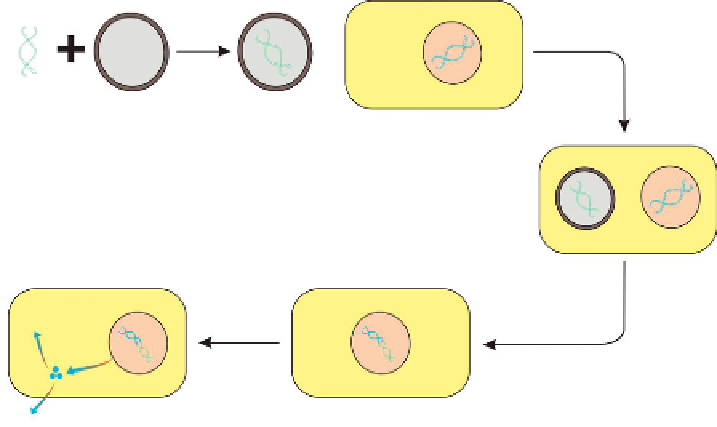Biomedical Engineering Reference
In-Depth Information
Nucleus
Gene to be
transferred
Target cell DNA
Vector
Intracellular
effect
Extracellular effect
Figure 6.1
Simplified schematic diagram on the basis of gene therapy. First, the foreign
genetic material to be delivered has to be packaged in a suitable vector. (A) Introduction of
the vector containing therapeutic genetic material into the cell cytoplasm. (B) Transfer of
therapeutic genetic material into the nucleus of the recipient cell, followed by integration to
cellular DNA. (C) Expression of the foreign therapeutic gene, resulting in synthesis of the
desired protein product.
gene can potentially cure the disease, which would be a significant improvement
over lifelong protein replacement therapy or no therapy at all. For acquired diseases
like cancer, gene therapy allows local production or cancer-cell targeted expression
of a therapeutic gene product. Basically, there are four protocols or strategies that are
used to achieve the goals of gene therapy.
1.
In vitro
approach
2.
Ex vivo
approach
3.
In situ
approach
4.
In vivo
approach
The
in vitro
approach utilizes reporter genes like
pEGFP
,
-gal
in the cultured cells
to evaluate the transfection efficiencies of a gene carrier system
[4]
. The
ex vivo
approach involves initial removal of the target cells from the body, which are then
cultured
in vitro
and incubated with vector containing the gene to be delivered. The
genetically altered cells are then reintroduced into the patient's body. This approach
is most frequently used for easily accessible body cells and tissues like epithelial
cells, blood cells, muscle cells, stem cells, and so forth
[5]
. The
in situ
protocols uti-
lize the direct injection of the DNA-vector system in close proximity of target cells
in the body, for example, in aerosol administration of the cystic fibrosis (CF) gene-
containing vector to the respiratory tract or direct injection of vectors in tumor mass.

Search WWH ::

Custom Search